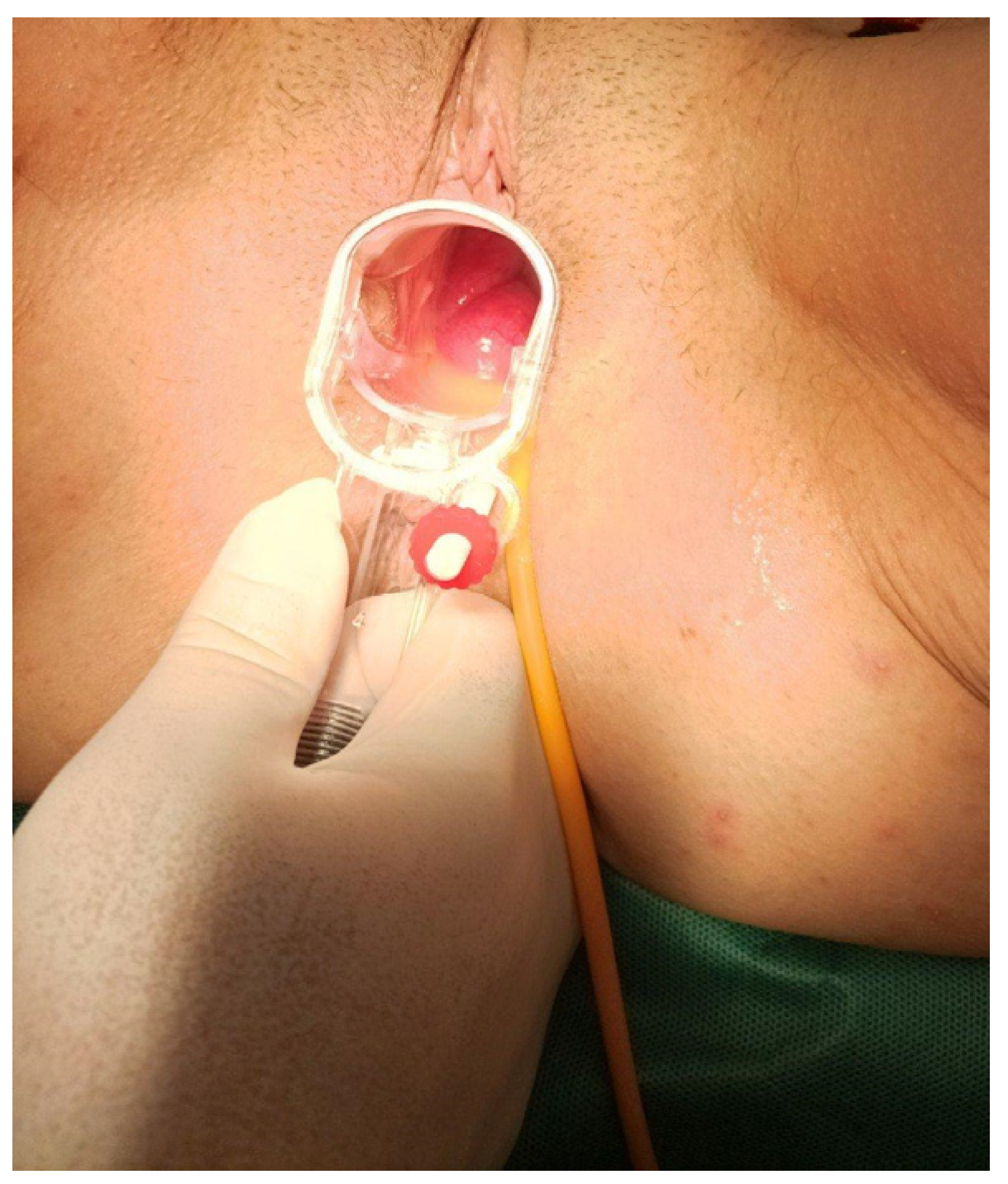Spontaneous Transvaginal Small Bowel Evisceration After Laparoscopic Hysterectomy
Abstract
:Author Contributions
Funding
Institutional Review Board Statement
Informed Consent Statement
Data Availability Statement
Conflicts of Interest
References
- Salad, N.M.; Omar, A.A.; Mohamed, Y.G. Spontaneous transvaginal small bowel evisceration secondary to vaginal cuff dehiscence after abdominal hysterectomy: A case report. Ann. Med. Surg. 2022, 79, 103986. [Google Scholar] [CrossRef] [PubMed]
- Alfraidi, R.; Abdulaaly, N.; Alharbi, A.; Almodhaiberi, H.; Ali, B.; Sabagh, H. Transvaginal small bowel evisceration: Case report and review of literature. Int. J. Surg. Case Rep. 2022, 96, 107322. [Google Scholar] [CrossRef] [PubMed]
- Parra, R.S.; Rocha, J.J.; Feres, O. Spontaneous transvaginal small bowel evisceration: A case report. Clinics 2010, 65, 559–561. [Google Scholar] [CrossRef] [PubMed]
- Omejc, A.; Janša, V.; Kobal, B.; Barbič, M. Spontaneous Transvaginal Intestinal Evisceration Two Years after Vaginal Hysterectomy, a Case Report. Medicina 2024, 60, 1388. [Google Scholar] [CrossRef] [PubMed]
- Chhabra, S.; Hegde, P. Spontaneous transvaginal bowel evisceration. Indian J. Urol. 2013, 29, 139–141. [Google Scholar] [CrossRef] [PubMed]
- Yanar, F.; Öner, G.; Özçınar, B.; Gök, A.F.K.; Ertekin, C. Spontaneous transvaginal small bowel evisceration following hysterectomy: A case report. Ulus Travma Acil Cerrahi Derg 2019, 25, 424–426. [Google Scholar] [CrossRef] [PubMed]
- Lee, D.H.; Kim, E.T.; Jo, H.B.; Hwang, S.Y.; Lee, N.K.; Suh, D.S.; Kim, K.H. Spontaneous reduction of transvaginal small bowel evisceration after abdominal hysterectomy for cervical cancer: A case report. Medicine 2022, 101, e29225. [Google Scholar] [CrossRef] [PubMed]
- Arabadzhieva, E.; Bulanov, D.; Shavalov, Z.; Yonkov, A.; Bonev, S. Spontaneous transvaginal intestinal evisceration in case of long-standing uterine prolapse. BMC Surg. 2022, 22, 157. [Google Scholar] [CrossRef] [PubMed]
- Kowalski, L.D.; Seski, J.C.; Timmins, P.F.; Kanbour, A.I.; Kunschner, A.J.; Kanbour-Shakir, A. Vaginal evisceration: Presentation and management in postmenopausal women. J. Am. Coll. Surg. 1996, 183, 225–229. [Google Scholar] [PubMed]
- Uccella, S.; Malzoni, M.; Cromi, A.; Seracchioli, R.; Ciravolo, G.; Fanfani, F.; Shakir, F.; Gueli Alletti, S.; Legge, F.; Berretta, R.; et al. Laparoscopic vs transvaginal cuff closure after total laparoscopic hysterectomy: A randomized trial by the Italian Society of Gynecologic Endoscopy. Am. J. Obstet. Gynecol. 2018, 218, 500.e1–500.e13. [Google Scholar] [CrossRef] [PubMed]


Disclaimer/Publisher’s Note: The statements, opinions and data contained in all publications are solely those of the individual author(s) and contributor(s) and not of MDPI and/or the editor(s). MDPI and/or the editor(s) disclaim responsibility for any injury to people or property resulting from any ideas, methods, instructions or products referred to in the content. |
© 2024 by the authors. Licensee MDPI, Basel, Switzerland. This article is an open access article distributed under the terms and conditions of the Creative Commons Attribution (CC BY) license (https://creativecommons.org/licenses/by/4.0/).
Share and Cite
Kountouri, I.; Giotas, A.; Gkogkos, C.; Katsarelas, I.; Nachopoulos, P.; Faseki, A.; Chatzinas, D.; Panagiotou, A.; Polychronidis, A.; Husamieh, M.; et al. Spontaneous Transvaginal Small Bowel Evisceration After Laparoscopic Hysterectomy. Diagnostics 2024, 14, 2498. https://doi.org/10.3390/diagnostics14222498
Kountouri I, Giotas A, Gkogkos C, Katsarelas I, Nachopoulos P, Faseki A, Chatzinas D, Panagiotou A, Polychronidis A, Husamieh M, et al. Spontaneous Transvaginal Small Bowel Evisceration After Laparoscopic Hysterectomy. Diagnostics. 2024; 14(22):2498. https://doi.org/10.3390/diagnostics14222498
Chicago/Turabian StyleKountouri, Ismini, Amyntas Giotas, Christos Gkogkos, Ioannis Katsarelas, Panagiotis Nachopoulos, Afroditi Faseki, Dimitrios Chatzinas, Alexandra Panagiotou, Athanasios Polychronidis, Mohammad Husamieh, and et al. 2024. "Spontaneous Transvaginal Small Bowel Evisceration After Laparoscopic Hysterectomy" Diagnostics 14, no. 22: 2498. https://doi.org/10.3390/diagnostics14222498
APA StyleKountouri, I., Giotas, A., Gkogkos, C., Katsarelas, I., Nachopoulos, P., Faseki, A., Chatzinas, D., Panagiotou, A., Polychronidis, A., Husamieh, M., Dimasis, P., Gkiatas, N., Manolakaki, D., & Chandolias, M. (2024). Spontaneous Transvaginal Small Bowel Evisceration After Laparoscopic Hysterectomy. Diagnostics, 14(22), 2498. https://doi.org/10.3390/diagnostics14222498





